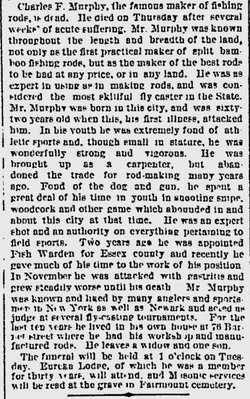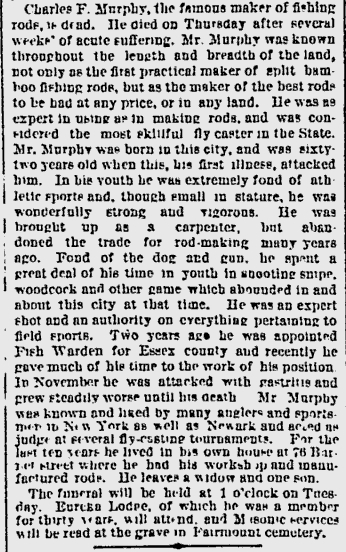In 1860, E. A. Green, of Newark, made a fine bamboo rod for his own use, and in 1863 Mr. Murphy turned out the first split bamboo rod for trout-fishing. It possessed the requisite toughness, lightness, and elasticity for casting an anchorless fly-line a distance of from 60 to 90 feet – a feat that could not be performed with rods made of ash, hickory, or lance-wood – and therefore it soon became popular. In 1865 Mr. Murphy made the first split bamboo salmon rod, and Dr. Andrew Clerk, of New-York, took it to Scotland, where it was highly prized by lovers of piscatorial sport. It was afterward used on the St. Lawrence River by Lewis C. Scott, and his account of its adaptability gave it a widespread popularity. In 1866 Mr. Murphy gave to the trade the first split bamboo rod for black bass fishing, and for a number of years Andrew Clerk and Co., of Maiden-lane, New-York, sold all the different varieties of rods he manufactured.
- classicflyrodforum.com
In 1860, E. A. Green, of Newark, made a fine bamboo rod for his own use, and in 1863 Mr. Murphy turned out the first split bamboo rod for trout-fishing. It possessed the requisite toughness, lightness, and elasticity for casting an anchorless fly-line a distance of from 60 to 90 feet – a feat that could not be performed with rods made of ash, hickory, or lance-wood – and therefore it soon became popular. In 1865 Mr. Murphy made the first split bamboo salmon rod, and Dr. Andrew Clerk, of New-York, took it to Scotland, where it was highly prized by lovers of piscatorial sport. It was afterward used on the St. Lawrence River by Lewis C. Scott, and his account of its adaptability gave it a widespread popularity. In 1866 Mr. Murphy gave to the trade the first split bamboo rod for black bass fishing, and for a number of years Andrew Clerk and Co., of Maiden-lane, New-York, sold all the different varieties of rods he manufactured.
- classicflyrodforum.com
Advertisement
Explore more
Sponsored by Ancestry
Advertisement


